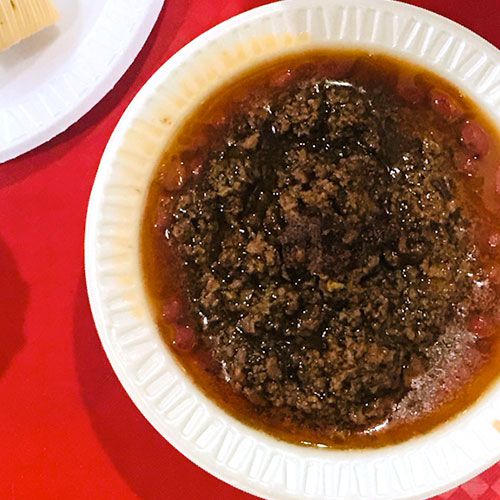The Chilli Capital of the World
A dispatch from the chilli capital of the world
I felt like I was eating hot lava. It was 1973, the day before I married a woman from Springfield, Illinois. I was young, brash, and foolish, and I had decided to mark the occasion with a bowl of the incendiary “firebrand” chilli (that’s the way they spell it) at the Den Chili (confusingly, that’s the way they spell it) Parlor.
That was my first encounter with chilli, and it turned out to be a painful lesson about eating dishes so extreme that they earn you a spot on the wall, especially just before a command performance. Later, though, I learned to appreciate the milder versions.
Springfield’s chilli tradition dates back to the late 1890s. I can remember the old folks reminiscing about the roving vendors who would push carts down the streets around the capitol building and courthouse, hawking their wares to lawyers and politicians. The most memorable was Ed DeCrastos. DeCrastos wore a white uniform, pushed a cart made by attaching a steam table to a baby buggy frame, and served tamales and chilli—in tin pie pans, topped with crackers—in an alley behind Allen’s Cigar Store.
Traditionally, the beans and meat cook separately, which allows for personalized orders. You can order your chilli without beans, with extra beans, with extra meat, or without meat. You specify how much “oil”—rendered fat—you want in the bowl.
The peculiar spelling is said to have originated with the opening of the Dew Chilli Parlor in 1909. Legend has it that the owner disagreed with his sign painter over the spelling, noting that the dictionary spelled it both ways. (“Chilli” is still the preferred spelling in the U.K. and Commonwealth countries, and it’s still listed as a legitimate option—though chiefly British—in Merriam-Webster.) Chilli was a Springfield favorite by the early 1900s and everywhere by the 1940s.
Springfield chilli calls for suet, beans, and a cumin-heavy spice blend. It is tomato-free. Traditionally, the beans and meat cook separately, which allows for personalized orders. You can order your chilli without beans, with extra beans, with extra meat, or without meat. You specify how much “oil”—rendered fat—you want in the bowl.
In the 1930s, Walt “Port” DeFrates put his Springfield chilli in glass jars and sold it as Port’s Brand Chili. His brother Ray took over and changed the name to Ray’s Chilli in 1936. Then Port’s son Joe DeFrates opened his own company, Chilli Man, in 1953. Both businesses succeeded beyond Springfield. New York Times food critic Mimi Sheraton once named Ray’s Chilli the best canned chili in America, then dropped it to number two after a reader sent her a can of Chilli Man.
In 1993, the state legislature approved a proclamation declaring Springfield “Chilli Capital of the Civilized Universe.” Note the spelling. Springfielders are protective of their chilli tradition, but the recipe below should pass any purity test. Lawson’s Tavern closed years ago, which allowed Franklin “Smitty” Smith, the chilli-maker there for two-and-a-half decades, to share the house recipe with the State Journal-Register.
Smitty’s Famous Lawson’s Tavern Chilli
Serves a crowd
Ingredients
4 ½ to 5 lb. ground suet
4 lb. coarse ground beef (This is sometimes called “chilli chuck.” Hamburger does not work very well—it tends to get too crisp.)
¾ cup chili powder
2 tbsp. salt
¾ tbsp. garlic powder
1 tsp. ground oregano
2 tsp. red pepper
3 tsp. ground cumin
Canned or cooked dried beans (Small red beans, although hard to find, are best for this dish. Don’t use kidney beans. Brooks Hot Chili Beans will work.)
Oyster crackers, for serving
Preparation
Add suet to a large pot over high heat with a cup of water. As it begins to heat up, stir frequently, to encourage rendering and prevent sticking. Bring it to a boil and hold it there, continuing to stir. When the mixture stops foaming, skim off all foam. Continue cooking until suet is rendered. Cracklings can be left in the pot if desired. If they taste strong, they should be omitted. Turn off the heat and let the oil cool slightly, from absurdly hot to hot.
Turn the heat back up to medium-high. Add meat, breaking up with a potato masher or large spoon, while cooking. Stir constantly, cooking until browned but not crisp. Add spices a few minutes before meat is done. Keep stirring. Don’t let the meat stick to the bottom of the kettle.
To serve, add heated beans—to taste—to the bottom of a bowl. Top with about 1/4 cup of chilli meat. Serve with crackers and let each person mix the beans and meat and his or her own bowl. The chilli meat can keep, preserved by the oil, for several weeks in the refrigerator or at least a year in the freezer if tightly wrapped.


